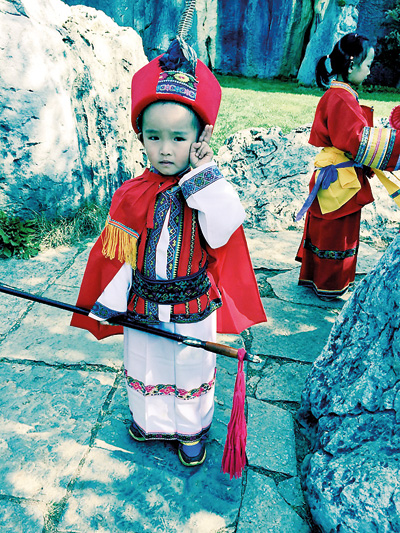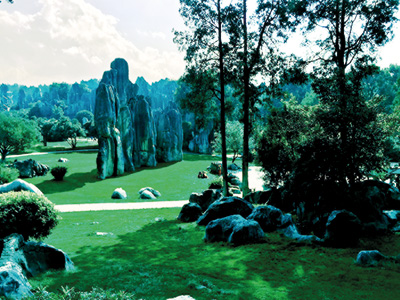In awe of Shilin Stone Forest
View(s):Yunnan province, the south west frontier and gateway to China, was one of the last strongholds of China, said Jin Cheng, Chief Counsel of the Foreign Affairs Office in Yunnan Province, meeting a Sri Lankan media group last month in his office. “The North South economic corridor is our success pattern,” he said, adding that improving connectivity is one among several priorities.
Flights are available to many major cities and capitals including daily flights to Sri Lanka. An improved road network connects with neighbouring countries such as Laos, Vietnam, Thailand, also a link up with Calcutta. Diversity in terms of ethnicity is an important feature of the province. Of the 55 ethnic minorities in China, 25 groups are found in Yunnan province. Among them, 16 groups live on both sides of the border.

Colourful costumes of the Yi people
Kunming, the capital of the province is known for its warm climate as well as the beauty of its landscape.A special attraction of Kunming is the Shilin Stone Forest whose fame dates back to the Ming Dynasty. It is found in LunanYi Nationality Autonomous Region, about 100 km from Kunmin.
The drive to the Stone Forest took about three hours by coach. Since it is spread over an area of 400 sq. km, there were open shuttle buses available to travel from one spot to another within the park. As we entered we could see all around us the towering stone formations in different shapes and sizes. It was an awesome sight.
Walking through the park with the clusters of natural stone masterpieces and varied formations, was an amazing experience. There were tall pinnacle shaped stones, some column-shaped and conical-shaped formations, interspersed with shorter groups of pagoda-shaped and mushroom-shaped formations as well. One could imagine the enormous stone formations to resemble human and animal shapes and faces and also trees. Some smaller ones atop the tall ones seemed to resemble heads on human figures. Some seemed precariously balanced. There were places where we had to walk through arch-shaped formations. The vast clusters of stone standing as silent sentinels looked like a veritable forest made of stone.Standing in groups as a backdrop against the lake, they made a truly spectacular sight.
Major Stone Forest, Minor Stone Forest, Naigu Stone Forest are sites in the area with clusters of natural stone formations. Naigu Stone Forest and Suogeyi Village have been declared UNESCO World Heritage Sites since 2007. According to geological research, the Stone Forest is a typical example of Karst topography, evolved over the past 200 – 300 million years as a result of earth and sea movement. The carbonate rock which formed in the ocean was over the years, shaped into the Stone Forest landforms. During the process of its evolution the Stone Forest was also covered by volcanic lava and water from the lake, which also had an effect on its formation into the spectacular and varied landforms we see today in Shilin. The most typical karst stone forest land forms can be seen here. Being a collection of all types of stone forest landforms, this geopark has high scientific and aesthetic values.
Our tour guide Selina told us about the Sani people of the Yi nationality who live around the stone forest area. They are from a minority ethnic group which has lived in the area for more than 2000 years. Their lives are as a result closely connected with the stone forest. They act as guides and custodians of the stone forest. The Yi people have a distinctive and colourful national costume, which they don particularly when visitors are in the park. Groups of them, colourfully clad were seen around the park. Selina pointed out the two triangles on the head gear of the women. When the triangles are pointing up, it indicates that the wearers are unmarried. When they are turned down, it means they are married. When one is up and the other is down, it indicates an engagement.
Many a legend relating to the Yi ethnic group, originates in the Shilin Stone Forest. The most well-known is the story concerning the rock of Ashima in the Small Stone Forest. It resembles a girl of the Sani people of the Yi ethnic group. According to the legend, Ashima, a beautiful young girl was kidnapped by an evil man and forced into marriage. Her lover Ahei rushed to save her with his magic bow and arrows. Ahei and the kidnapper competed by singing for three days and three nights. Ahei finally won the contest but on the way home, Ashima was drowned in a flood and became what is known as the Ashima rock. She is seen as a protector of the Sani people.

Awe inspiring:The natural stone formations at the Stone Forest
In a clearing in the Stone Forest, the Yi people clad in their colourful costumes, display their handwork in a collection of stalls. Their costumes were displayed for sale along with basketware, colourful and intricate embroidered purses, bags and varied other items. They also posed for instant photographs with visitors, which they sold to them. It was a hive of activity, with visitors and the Yi people mingling together. The native people were also seen seated in groups in shady spots, having their mid-day meal. Our guides told us about the annual Torch Festival which the Yi people celebrate. They also participate in several traditional performances, such as folk dances and wrestling competitions, which draw many visitors, making it a popular destination. Yet, the greatest attraction of this site is the awesome collection of stone sculptures, evolved over centuries.


